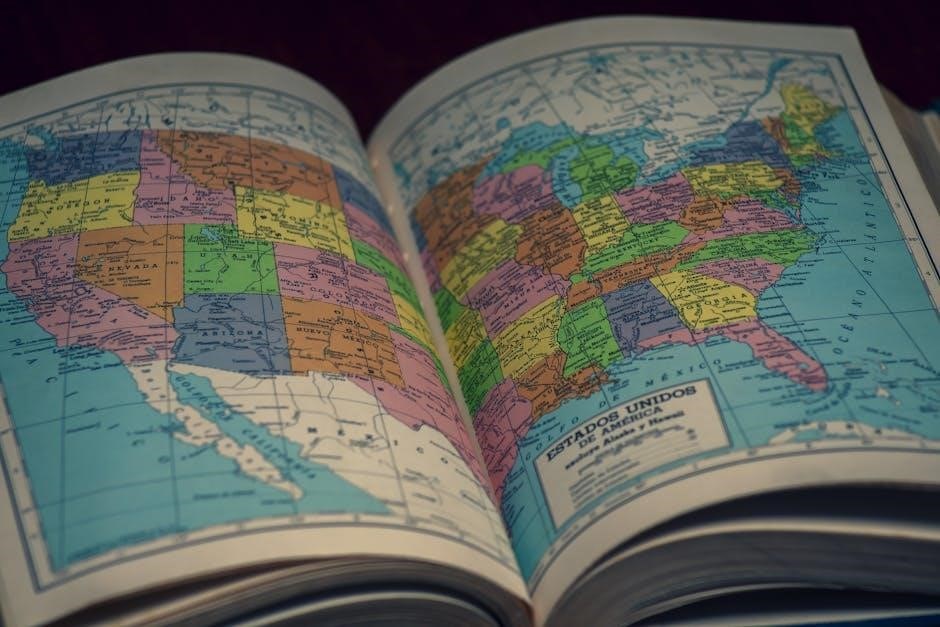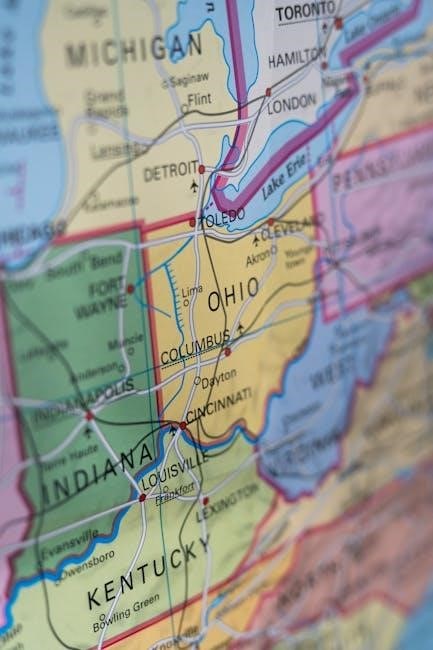Learning state capitals is essential for understanding U․S․ geography, history, and civic engagement․ This guide provides a comprehensive overview, making it easier to master state capitals through interactive tools and resources․
1․1 Importance of Learning State Capitals
Learning state capitals is crucial for understanding U․S․ geography, history, and civic engagement․ It enhances knowledge of regional cultures and economies, aiding in academic and professional contexts․ Memorizing capitals improves navigation skills and supports travel planning․ Additionally, it prepares students for standardized tests, competitions, and trivia quizzes․ Knowing capitals fosters a deeper appreciation for the nation’s diversity and historical development․ It also aids in identifying states on maps, a skill essential for various careers․ Many resources, like flashcards and quizzes, make learning capitals engaging and effective․ This foundational knowledge is vital for lifelong learning and intellectual growth, providing a strong base for advanced studies in history, politics, and geography․
1․2 Overview of the Study Guide
This study guide offers a structured approach to mastering U․S․ states and their capitals․ It includes regional breakdowns, interactive tools, and practical resources․ The guide covers all 50 states, organized by regions like Northeast, South, Midwest, Southwest, and Northwest․ Each section provides maps, flashcards, and quizzes to aid memorization․ Printable lists and blank maps are available for hands-on practice, while online quizzes test knowledge retention․ Mnemonics and memory aids are also included to enhance learning․ The guide is designed for students, educators, and enthusiasts, catering to different learning styles․ Whether preparing for exams or personal enrichment, this comprehensive resource ensures a thorough understanding of U;S; geography․ Its clear structure and diverse tools make learning states and capitals engaging and effective, suitable for all skill levels and learning preferences․

Regional Breakdown of States and Capitals
This section organizes states and capitals into key regions, including Northeast, South, Midwest, Southwest, and Northwest․ Each region highlights its unique states and capitals for focused learning․

2․1 Northeast States and Capitals
The Northeast region includes states like Maine, New Hampshire, Vermont, Massachusetts, Rhode Island, Connecticut, New York, New Jersey, and Pennsylvania; Their capitals are Augusta, Concord, Montpelier, Boston, Providence, Hartford, Albany, Trenton, and Harrisburg, respectively․ These states are historically significant, with many playing crucial roles in American history․ Maine is known for its coastline, while New York is famous for its bustling cities․ Pennsylvania, home to Philadelphia, is rich in colonial heritage․ This region’s compact size makes it easier to learn and remember its capitals, offering a great starting point for beginners․ Using maps and flashcards can enhance retention of these Northeast states and their capitals․
2․2 Southern States and Capitals
The Southern United States encompasses states such as Alabama, Arkansas, Florida, Georgia, Kentucky, Louisiana, Mississippi, North Carolina, Oklahoma, South Carolina, Tennessee, Texas, Virginia, and West Virginia․ Their capitals include Montgomery, Little Rock, Tallahassee, Atlanta, Frankfort, Baton Rouge, Jackson, Raleigh, Oklahoma City, Columbia, Nashville, Austin, Richmond, and Charleston․ This region is culturally rich, with significant historical landmarks and vibrant cities․ Florida is known for its beaches, while Texas stands out as the largest state․ Virginia is notable for its colonial history, and Louisiana is famous for New Orleans․ To effectively learn these capitals, utilizing maps and flashcards can aid in memorization․ Additionally, grouping states by proximity or similarity can help in organizing study sessions․
2․3 Midwestern States and Capitals
The Midwest includes states such as Illinois, Indiana, Iowa, Kansas, Michigan, Minnesota, Missouri, Nebraska, North Dakota, Ohio, South Dakota, and Wisconsin․ Their capitals are Springfield, Indianapolis, Des Moines, Topeka, Lansing, St․ Paul, Jefferson City, Lincoln, Bismarck, Columbus, Pierre, and Madison․ This region is known for its agricultural significance and vast plains․ Illinois is home to Chicago, a major city, while Michigan boasts the Great Lakes shoreline․ Ohio is notable for its industrial history, and Minnesota is recognized for its natural beauty․ To master these capitals, creating associations or using mnemonic devices can be effective․ Additionally, practicing with blank maps or online quizzes can reinforce memory and improve retention of Midwestern states and their capitals․
2․4 Southwestern States and Capitals
The Southwest encompasses states like Arizona, New Mexico, Texas, Nevada, and Oklahoma․ Their capitals are Phoenix, Santa Fe, Austin, Carson City, and Oklahoma City․ This region is known for its desert landscapes, rich Native American history, and vibrant cities․ Arizona is famous for the Grand Canyon, while Texas stands out for its size and diverse culture․ Nevada’s capital, Carson City, is smaller but historically significant․ To study these capitals effectively, associating each with its state’s unique features can help․ For instance, linking Arizona with the Grand Canyon and its capital Phoenix․ Using flashcards or blank maps can also aid in memorization․ Understanding the cultural and geographical context of each state enhances learning and retention of Southwestern capitals․
2․5 Northwestern States and Capitals
The Northwestern United States is home to several states with unique capitals․ Washington’s capital is Olympia, known for its historic sites and proximity to the Olympia National Park․ Oregon’s capital is Salem, rich in cultural heritage and home to the Oregon State Capitol building․ Idaho’s capital is Boise, famous for the Boise River and its vibrant downtown area․ Montana’s capital, Helena, boasts a charming downtown with historic architecture․ Wyoming’s capital, Cheyenne, is renowned for its frontier history and the annual Cheyenne Frontier Days․ Alaska’s capital, Juneau, offers breathtaking natural beauty with access to the Mendenhall Glacier․ Hawaii’s capital, Honolulu, is a vibrant tourist hub and the gateway to the Hawaiian Islands․ To effectively memorize these capitals, students can associate each capital with distinctive state features, such as landmarks or cultural events․ Additionally, using study tools like printable maps, flashcards, or online quizzes can enhance retention and make learning engaging․

Study Tools and Resources
Explore essential study tools like printable state and capital lists, flashcards, blank maps, and online quizzes․ These resources help streamline learning and reinforce retention effectively for students․
3․1 Printable States and Capitals List
A printable states and capitals list offers a clear, organized way to review and study․ These lists are often formatted in alphabetical order, making it easy to locate specific information quickly․ Many resources include the state’s abbreviation alongside its capital, providing a comprehensive reference․ Printable lists can be used for quick review sessions or as a study aid for exams․ They are especially useful for visual learners who benefit from seeing information laid out in a structured manner․ Additionally, printable lists can be paired with other study tools, such as maps or flashcards, to create a well-rounded study routine․ This method ensures that learners can efficiently memorize all 50 states and their corresponding capitals․
3․2 Flashcards for Memorization

Flashcards are a powerful tool for memorizing states and their capitals․ They allow learners to focus on one state at a time, making the process manageable and effective․ Physical flashcards can be carried anywhere, enabling spontaneous study sessions․ Digital flashcards, available through apps like Quizlet, offer interactive features such as spaced repetition and audio pronunciation․ Many flashcard sets include the state’s abbreviation, capital, and even a map for visual reinforcement․ Users can quiz themselves by covering the answer side or testing a friend․ This method reinforces memory retention and builds confidence․ For parents or educators, custom flashcards can be created to focus on specific regions or difficult states․ Regular use of flashcards is a proven strategy for mastering state capitals efficiently․
3․3 Blank Maps for Practice

Blank maps are an excellent resource for practicing state and capital recognition․ They provide a hands-on way to visualize the United States and its regions․ By filling in the states and their capitals, learners can identify areas where they need improvement․ Blank maps are available in both printable and digital formats, offering flexibility for different learning styles․ They often include outlines of state borders, rivers, and mountains to aid in geographical association․ Regular practice with blank maps helps build spatial awareness and reinforces memory retention․ Educators recommend using them alongside flashcards and study guides for a comprehensive learning experience․ Over time, consistent practice with blank maps leads to mastery of state and capital locations, making them an invaluable tool for any study routine․
3․4 Online Quizzes and Tests
Online quizzes and tests are dynamic tools for assessing and improving knowledge of state capitals․ Websites like Quizlet and Encyclopaedia Britannica offer interactive quizzes that cover all 50 states․ These resources feature multiple-choice questions, fill-in-the-blank exercises, and clickable maps to test knowledge in various formats․ Many quizzes provide immediate feedback, highlighting correct answers and explaining mistakes․ This feature helps learners identify gaps in their knowledge and focus on challenging areas․ Additionally, some platforms allow users to track progress over time, offering a motivating way to measure improvement․ Online quizzes are accessible anytime, making them convenient for self-paced learning․ They are ideal for both students and educators, serving as a fun and engaging way to reinforce state and capital memorization․ Regular use of these tools enhances retention and ensures long-term mastery of the material․
3․5 Mnemonics for Better Retention
Mnemonics are powerful techniques that enhance memory retention by associating information with memorable cues․ For learning state capitals, create acronyms or rhymes․ For example, “Sacramento” for California can be linked to “socks always cover my toes․” Visualize maps with capital locations or use associations like “Olympia” for Washington by imagining the Olympic Games․ Group states by regions, such as Northeast capitals, and create stories or songs․ Memory aids like these make complex information digestible and fun, reducing study time and boosting confidence․ Consistent practice with mnemonics ensures long-term retention, making mastering state capitals more achievable and enjoyable․ These strategies are adaptable to various learning styles, providing effective ways to remember even the most challenging capitals․ Mnemonics transform rote memorization into engaging and creative learning experiences․

Interesting Facts About State Capitals

State capitals vary in size and history, with some being populous cities while others are smaller towns; Discover unique facts about their origins and significance․
4․1 Most Populous State Capitals
Among U․S․ state capitals, some stand out for their large populations and vibrant cultures․ Sacramento, the capital of California, is one of the most populous, known for its political significance and diversity․ Phoenix, Arizona’s capital, is another major city, serving as a hub for business and tourism․ Austin, the capital of Texas, is renowned for its music scene and technological innovation; Columbus, Ohio’s capital, is a bustling city with a strong economy and cultural landmarks․ Denver, Colorado’s capital, is famous for its outdoor recreation opportunities and growing population․ These cities highlight the importance of state capitals beyond governance, showcasing their roles as economic and cultural centers;
4․2 Oldest and Youngest State Capitals
Exploring the history of U․S․ state capitals reveals fascinating insights into their origins and development․ Boston, Massachusetts, is one of the oldest state capitals, dating back to 1630, and has played a pivotal role in American history․ Similarly, Santa Fe, New Mexico, is the oldest capital city in the United States, founded in 1610, long before it became a state․ On the other hand, Honolulu, Hawaii, became a state capital in 1959, making it one of the youngest․ Juneau, Alaska, also gained its status as a capital in 1959 when Alaska was admitted to the Union․ These examples highlight the diverse historical backgrounds of state capitals, from colonial roots to modern establishments, offering a unique perspective on the nation’s growth and evolution․
4․3 Unique Names of State Capitals
U․S․ state capitals often have distinctive and intriguing names that reflect their cultural, historical, or geographical roots․ Names like Topeka (Kansas), Olympia (Washington), and Boise (Idaho) stand out for their uniqueness․ Many capitals, such as Pierre (South Dakota) and Juneau (Alaska), have origins tied to early settlers or significant events․ Some names, like Cheyenne (Wyoming) and Tallahassee (Florida), derive from indigenous languages, adding a layer of cultural depth․ These unique names not only make state capitals memorable but also highlight the diversity of the United States․ Learning these names can be engaging due to their distinctiveness and the stories behind them, making the process of mastering state capitals both educational and enjoyable․
Mastering state capitals enhances geographic knowledge and cognitive skills․ Utilize tools like flashcards, maps, and quizzes to succeed in mastering this essential information for lifelong learning and enjoyment․
5․1 Final Tips for Mastering State Capitals
Consistency is key to mastering state capitals․ Set aside time daily to review flashcards or maps, focusing on regions at a time․ Use mnemonics or associations to remember tricky capitals, like linking names to landmarks or personal experiences․ Test yourself frequently with online quizzes to track progress․ Teach others what you learn to reinforce your own knowledge․ Stay organized with a printable list or study guide, marking off capitals as you master them․ Celebrate small victories to stay motivated, and don’t hesitate to seek additional resources when needed․ With dedication and the right strategies, you’ll confidently know all state capitals in no time․

5․2 Resources for Further Learning

Supplement your study with a variety of resources to deepen your understanding of state capitals․ Utilize online platforms like Quizlet for interactive flashcards and practice tests․ Printable maps and study guides are excellent for visual learners, allowing you to label and review capitals at your own pace․ Websites such as Encyclopaedia Britannica offer quizzes to test your knowledge and identify areas for improvement․ Additionally, downloadable lists of states and capitals can serve as quick reference materials․ For a hands-on approach, explore educational apps or interactive games that make learning engaging․ Join study groups or forums to collaborate with others and share tips․ With these tools, you can reinforce your knowledge and ensure long-term retention of state capitals․
